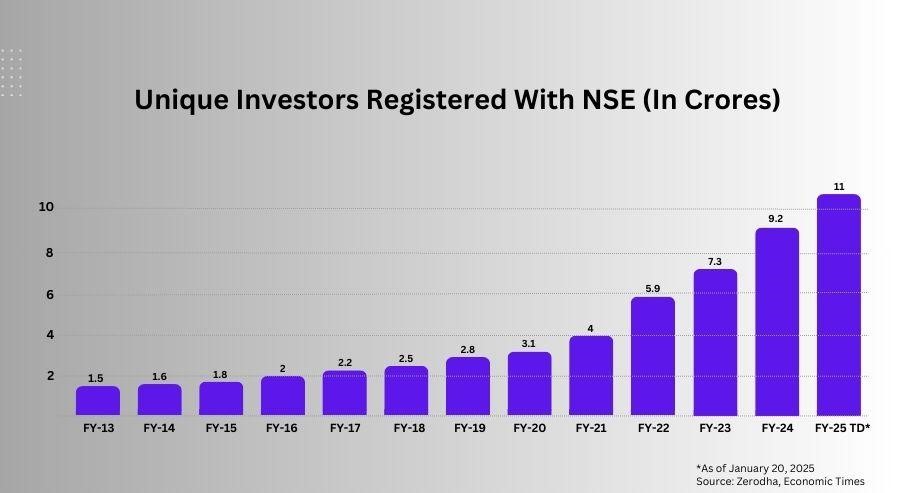Table of Contents
Who Are Foreign Institutional Investors (FIIs)?
FIIs and the Indian Market
Did FIIs Drive the Indian Stock Market Boom of Recent Years?
Why Did FIIs Buy Heavily in India in 2023?
Are FIIs Driving the Recent Indian Market Downfall?
Will FIIs Make a Comeback Soon?
What Should Retail Investors Do?
Conclusion
In 2023, Foreign Institutional Investors (FIIs) poured ₹3.39 lakh crore into the Indian market, fueling a record-breaking market rally.
Fast forward to 2025, the momentum has reversed—FIIs have offloaded $15 billion so far, sparking a relentless sell-off. This massive outflow erased over $1.3 trillion in investor wealth and triggered one of the longest losing streaks in market history (as of 10 March 2025).
FIIs have always had a big impact on the Indian stock market, driving both rallies and sell-offs. But do they really control where the market goes? While their investments have pushed markets to record highs, Indian investors have also played a strong role.
Now that FIIs are selling heavily, the big question is—how much do they really matter?
Who Are Foreign Institutional Investors (FIIs)?

Foreign Institutional Investors (FIIs) refer to individuals, institutions, or entities that invest in a country’s financial markets while being headquartered elsewhere. These investors play a crucial role in emerging economies by injecting capital into businesses, fostering economic growth, and enhancing market liquidity.
FIIs typically include hedge funds, mutual funds, insurance companies, and investment banks that hold equity positions in foreign markets. Their investments help strengthen the capital structure of companies by ensuring a steady inflow of funds, which can drive financial innovation and boost market expansion.
However, FII activity can significantly impact domestic markets. Their large-scale investments influence currency demand, affect inflation, and contribute to market volatility.
FIIs and the Indian Market
FIIs play a crucial role in the Indian stock market by providing foreign capital, increasing liquidity, and improving market efficiency. Their investments help fill the gap between domestic savings and investment needs, driving economic growth.
Beyond capital inflows, FIIs bring global expertise and advanced investment strategies. Their research-driven approach strengthens corporate governance, risk management, and market efficiency.
By actively trading in Indian securities, they boost liquidity, making it easier for investors to buy and sell stocks while improving price discovery and reducing transaction costs.
FIIs also help stabilize the market. Their long-term investments balance short-term market fluctuations caused by domestic investors, reducing volatility.
Recognizing their significance, regulators have introduced policies to attract and manage FII investments, ensuring their contributions benefit the Indian financial ecosystem.
Did FIIs Drive the Indian Stock Market Boom of Recent Years?
Over the past six years (2019-2024), the Indian stock market has delivered an average annual return of 13.92%, with standout years like 2021 (24.12%) and 2023 (19.42%).
To what extent FIIs contributed to this growth is a question that requires detailed analysis, especially considering the significant changes in the Indian market post-COVID—most notably, the surge in Demat account openings and increased retail participation.
In FY 2020, India had 3.1 crore unique investors on the NSE, nearly double the count from 2013. While it took seven years to achieve this growth, the number of unique investors skyrocketed to 11 crore by January 2025.

Now, let’s examine Nifty 50 returns and FII investments during this period.
| Year | Total FII Inflows to Indian Market (In Crores) |
| 2019-2020 | -27529.17 |
| 2020-2021 | 267099.99 |
| 2021-2022 | -122239.83 |
| 2022-2023 | -40936.98 |
| 2023-2024 | 339064.62 |
FII Investments data 2019-2024
| Year | Nifty 50 returns |
| 2019 | 12.02 |
| 2020 | 14.90 |
| 2021 | 24.12 |
| 2022 | 4.32 |
| 2023 | 19.42 |
| 2024 | 8.75 |
Nifty-50 return data 2019-2024
In FY 2021-22 alone, FIIs pulled out nearly ₹1.22 lakh crore from Indian equities, a sharp reversal from FY 2020-21, when they invested around ₹2.67 lakh crore. The Indian equity market faced multiple challenges during this period.
FIIs exited due to geopolitical risks from the Russia-Ukraine war, rising crude prices, inflationary pressures, and higher US interest rates, which made global markets more attractive.
The data clearly shows that FII outflows have historically led to market downturns, while strong inflows have driven higher returns. Despite a surge in domestic and retail investor participation, the market grew by only 4.32% in 2022 as FIIs continued their sell-off into 2022-23.
However, a strong FII buying streak in the latter half of 2023, combined with robust retail participation, helped the market recover, delivering an impressive 19.42% return.
While this buying trend continued into early 2024, the market took a hit from October onward, followed by intensified foreign outflows triggering a downward trend.
Before analyzing the recent sell-off, let’s first understand what made India an attractive destination for foreign investors in the first place.
Why Did FIIs Buy Heavily in India in 2023?

FII investments in India have historically followed global trends, with periodic inflows and outflows. While short-term geopolitical and market shifts often cause fluctuations, 2023 saw a strong buying streak due to several key reasons:
1. Political Stability Post Assembly Elections
The BJP’s sweeping victories in three major state elections reassured FIIs about political continuity in India. Investors viewed this as an indicator that the ruling party would likely retain power in the 2024 General Elections, reducing political uncertainty—a factor that often influences foreign investment decisions.
2. Robust Economic Growth Surpassing Expectations
India’s GDP growth for Q2FY24 came in at an impressive 7.6%, well above the 6.5% estimate by the RBI. This growth was further reinforced by strong high-frequency indicators:
- GST collections rose by 9%
- Industrial Production (IIP) grew by 8%
- Consumer Inflation (CPI) dropped to 9%
These positive macroeconomic trends strengthened confidence in India’s economic resilience, making it an attractive destination for FIIs.
3. Declining US Treasury Yields and Market Rebound
Earlier, FIIs had been reducing exposure to emerging markets as US bond yields climbed to 5%. However, as yields started to decline, global investors reallocated capital to higher-growth markets like India. This shift was further supported by post-election market optimism, leading to fresh investments by FIIs.
4. Attractive Valuations & Currency Advantage
Compared to other emerging markets, Indian equities remained a strong value proposition. Additionally, the weakening Indian rupee provided FIIs with more purchasing power, allowing them to buy Indian assets at a relatively lower cost.
5. Increased Weight of India in Global Indices
India’s growing importance in global indices also contributed to higher foreign inflows:
- Indian Government Bond included in the JPMorgan Government Bond Index, making them appealing to more global investors.
- MSCI Emerging Markets Index increased India’s weightage to 3% from 15.9%.
A combination of political stability, strong economic growth, favorable global bond market trends, attractive valuations, and India’s rising weight in global indices made the country a prime investment destination in 2023.
With increased foreign inflows, the market gained momentum, pushing the Nifty 50 and Sensex to new highs and boosting investor confidence.
Are FIIs Driving the Recent Indian Market Downfall?

The Indian stock market has been under pressure for the past few months, with the downturn starting in October 2024 as well as FIIs began withdrawing their investments. This large-scale withdrawal further deepened the market correction.
Nifty 50 hit its all-time high of 26,277.35 on September 27 last year. As of 03 March 2025, it closed at 22,119.30, marking a decline of 4,158 points, or 15.82% from its peak.
Several factors have contributed to this decline, with foreign investor sentiment playing a key role.
Although we can’t attribute this downturn solely to the FIIs’ selling streak, it’s clear that their outflows have intensified the decline.
Let’s look at the major reasons behind the current decline in the Indian market and the role FIIs play in it.
1. US Elections, Federal Reserve Policies & Global Uncertainty
Market sentiment turned cautious post-September, ahead of the US presidential elections in November. Following the election, uncertainty over the new administration’s trade policies raised concerns about potential trade tensions.
Additionally, expectations of further rate cuts by the US Federal Reserve have diminished. In fact, some experts believe the era of ultra-low interest rates is over, signaling a prolonged period of elevated borrowing costs. Rising US interest rates make global markets more attractive, leading to capital outflows from emerging markets like India.
2. Slowing Economic Growth Raises Concerns
Concerns over a slowing domestic economy have unsettled foreign investors, who once saw India as a bright spot amid global uncertainty.
India’s GDP declined for three consecutive quarters, from Q4FY24 to Q2FY25. Even in Q3FY25, GDP growth slowed to 6.2%, its weakest pace since Q4FY23 (excluding the previous quarter, which saw 5.6% growth).
With economic expansion lagging behind RBI and NSO projections, some economists predict lower-than-expected GDP growth for FY25.
Government spending remained subdued in the first half of the year due to national and state elections, while erratic monsoons further dampened economic activity. Weak consumer demand, both in rural and urban areas, worsened the outlook, heightening investor concerns.
3. Weak Earnings
Corporate earnings in India disappointed for three consecutive quarters (Q1, Q2, and Q3), raising concerns about overvaluation. Despite record-high stock prices fueled by domestic retail investors, stretched valuations needed a correction.
4. Rupee at Record Lows
The Indian rupee has fallen to a record low in recent times amid macroeconomic weakness and the dollar’s strength against its peers. A weaker rupee reduces FIIs’ returns when converted back to dollars, making Indian assets less attractive.
It also signals economic uncertainty, prompting foreign investors to shift their capital to more stable markets, further weighing on market sentiment.
5. Shifting Narrative: ‘Buy China, Sell India’
Rising US treasury yields, strong economic growth in America, and an appreciating dollar have made global investors rethink their positions. At the same time, China’s stock market has staged a strong comeback, drawing FIIs away from India.
Since October 2024, the Indian stock market has lost over $1 trillion in market capitalization, while China has gained $2 trillion (as of Feb 2025).
The Hang Seng Index surged 16% in just one month, while the Nifty declined by over 2%. FIIs are returning to China, attracted by factors like the rise of DeepSeek, relatively cheaper valuations, and solid earnings from companies like Alibaba and Lenovo.
What once drove strong foreign inflows into India has now shifted, leading to a reversal in sentiment. When market conditions turned pessimistic in October 2024, FIIs began exiting, intensifying the downturn.
While their outflows played a significant role in this wipeout, the underlying reasons lie in factors like India’s economic slowdown, valuation concerns, and the rising appeal of other global markets.
Will FIIs Make a Comeback Soon?

Analyzing the reasons behind FIIs’ buying streaks and sell-offs, it’s evident that both India’s economic conditions and the global financial landscape have undergone significant changes.
FII investments in India have historically fluctuated, with periods of inflows and outflows driven by varying global and domestic factors. For instance, after two years of outflows in 2018-19 and 2019-20, FIIs made a strong comeback in 2020-21. Similarly, heavy selling in 2021-22 and 2022-23 was followed by a rebound in 2023-24.
While past trends suggest that FIIs do return after sell-offs, the current outlook does not indicate an immediate comeback. Beyond the reasons mentioned earlier, India presents certain challenges that make it less appealing compared to other global markets:
- India is one of the most expensive equity markets globally. Aswath Damodaran, Professor of Finance at NYU, points out that Indian stocks trade at 31 times earnings, 3 times revenue, and 20 times EBITDA—far above global averages. Such high valuations make investors cautious, especially when more reasonably priced opportunities exist elsewhere.
- Lower Returns – In 2024, global markets outperformed India. The US delivered 23%, Japan and Hong Kong 15-19%, and the Middle East topped at 26%, while India lagged at just 8%.
- Taxation Challenges – Unlike many global markets where FIIs enjoy tax-free gains, India imposes a 12.5% long-term capital gains tax (LTCG) and a 20% short-term capital gains tax (STCG), making it a less attractive investment destination.
Despite these challenges, market experts point to external factors that could shift FIIs’ focus back to emerging markets like India. These include the impact of tariffs on the US economy and the possibility of a market correction in the US, coupled with a recovery in Indian corporate earnings.
What Should Retail Investors Do?

The Indian stock market has seen a significant surge in retail participation in recent years, especially post-COVID. The sharp rise in demat accounts brought in many first-time investors, driven by optimism and attractive returns.
While some followed a disciplined approach, others invested heavily in stocks or mutual funds without proper risk assessment or diversification. The recent market correction—triggered by sustained FII outflows and various macroeconomic factors—led to a 15%+ decline in Nifty from its all-time high, leaving many retail investors unsettled.
The Indian market has historically remained resilient despite global geopolitical crises. However, the current downturn has tested investors in new ways. Unlike FIIs, who shift capital across geographies based on risk-reward dynamics, retail investors primarily earn, spend, and invest within India.
FII movements impact short-term volatility, but they may not determine long-term market trends.
This phase serves as an important learning experience, emphasizing the need for a structured investment strategy. These are the key lessons investors should keep in mind going forward.
Keep Cash Reserves: Market corrections create buying opportunities. Having cash on hand enables investors to buy quality stocks at lower valuations.
Follow Systematic Investing: Instead of chasing market tops and bottoms, maintain a disciplined approach with regular investments through SIPs.
Stick to the Plan: Wealth creation requires patience. Instead of making impulsive decisions based on market movements, create a plan based on your investment goals and risk appetite – and do proper periodic reviews to ensure you are on track.
This doesn’t mean you should start buying every dip, hoping for a quick market recovery. The reality is, we don’t yet know how long this downturn and FII sell-off will continue—or whether it could worsen.
That’s why it’s crucial to stay informed about global trends, economic conditions, and India’s market outlook before making investment decisions.
One key lesson from this phase is that investing isn’t as simple as it may seem. A well-structured plan is essential to navigate market cycles effectively.
Market ups and downs are inevitable, and your portfolio won’t always be in the green, even with a solid strategy. There will be days of negative returns and days of gains. But historically, long-term investors have seen better returns over time.
For short-term investments, choosing the right asset class is critical to managing risk and ensuring liquidity when needed.
So, whether you hold on to your existing investments or make new ones, your decisions should align with your financial goals and risk appetite rather than emotionally reacting to market movements.
If you’re unsure about your investment strategy, professional guidance can make a big difference. A financial expert can help you stay on track with a well-planned approach tailored to your goals.
For those who prefer mutual funds to benefit from expert fund management, consulting a mutual fund distributor can provide clarity on fund selection, asset allocation, and necessary portfolio adjustments when needed.
Platforms like Moolaah help you find the right mutual fund distributor by listing their name, education, and expertise. Investors can explore the list, choose the right fit based on their needs, and start investing in mutual funds with expert guidance.
Conclusion
Foreign Institutional Investors (FIIs) have a significant influence on the Indian market, but they are not its sole driver. Key factors like Domestic investors, economic growth, and corporate earnings contribute to long-term stability.
While FII outflows may bring volatility, India’s markets have consistently rebounded, attracting them back.
The future of the Indian market will be shaped by how India tackles challenges, resolves key issues, and how global market trends enhance its attractiveness, drawing FIIs back to invest.




